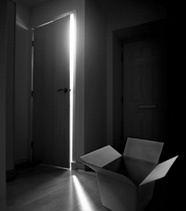Shining City at Huntington Theatre Company
Haunting Psychological Mystery and Ghost Story
By: Mark Favermann - Mar 17, 2008
Shining City
By Conor McPherson
Directed by Robert Falls
3/7/2009 through 4/6/2008
The Cast
Keith Gallagher as Laurence
John Judd as John
Jay Whittaker as Ian
Nicole Wiesner as Naesa
The Crew
Set Designer Santo Loquasto
Costume Designer Kay Voyce
Lighting Designer Christopher Akerlind
Sound Designer Obadiah Eaves
Vocal & Dialect Coach Linda Gates
Production Stage Manager Eileen Ryan Kelly
Stage Manager Kayla Sullivan
BU Theatre-Mainstage
Huntington Theatre Company
http://www.huntingtontheatre.org
Approximate Running Time: 1 hour and 30 minutes
Like Irish music, even the most joyous Irish plays often seem to have a lilt of sadness even when they are celebratory. There is a dark shadow that dramatically falls. This is true of the play Shining City by Irish playwright Conor McPherson. It tells the story of a stressed out Dublin therapist as he treats and seemingly cures a man haunted by the ghost of his violently killed wife. At the same time, the therapist's own individual relationships and personal growth sway over an emotional abyss. This play is a strong psychological drama/mystery. Also, it was on this past season's lists of Broadway's Best.
Shining City is a contemporary ghost story set in modern day Dublin with its booming Euro-economy, rising middle class, and shifting social mores. This play is about poverty of emotion rather than traditional economic poverty. Today, Ireland is one of the most vital economic engines in the European Union. Located in the therapist's office/apartment, the single set staging encloses an expansive, yet somehow cramped world, created by the playwright. Each of the entrances and exits of all the characters are awkward stumblings in Ian the therapist's life and actions.
The door doesn't open well, the guest buzzer works badly, and Ian seems to move uncomfortably around the door and his visitors. We see through a window the rather beautiful but conservative building facades and rooftops of a rather warm and welcoming urban Dublin. Outside is more inviting than the inside. The interior of the apartment is a bit tired, quite impersonal, and even cold. It is not homey, nor comfortable. Here, Dublin, and thus the real world, are outside ourselves. Today, Dublin is a literaly shining city. But is our own exterior environment unblemished?
The apartment interior mirrors the emotional disconnect to the real world of the therapist and his patient. It reflects the tawdriness of his own relationship to the mother of his young child, the awkwardness of a relationship to his brother as well as personal and sexual clumsiness since leaving the priesthood. The single set was brilliantly created by the master designer, Tony-award winner, Santo Loquasto.
Add to this physical environment that the patient, John, is initially in great psychological and seemingly physical pain. When he first enters, he appears to be a hollow, older man. He is agonizingly wrestling with the guilt of having an affair prior to his wife's awful, sudden death in a car crash, juxtaposed with the therapist Ian's awkward dissolution of his relationship with his daughter Ashley's mother. John is childless while Ian recently became a father. John appears to be godless; Ian has recently left the priesthood. Both men have issues with relationships with their families and especially their brothers. They grapple with their sexuality in very different ways. Defining manliness seems to be a prevailing Irish theme.
As John's therapy advances, he seems to actually become younger and more vital. At the end of the play, he is transformed into a youngish, middle aged man. Ian seems to become less stabile and more tentative. John confronts his past and a former amorous relationship while Ian seems to deal with his own fiancé in a cold and emotionless way while experimenting with homosexuality. Each seems to get to understand better their own individual path.
The strongest character in the play was John. Played by a very human, and quite empathetic, John Judd, this character was an everyman, an upwardly mobile, lower middle-class, salesman who, at times, seemed a bit astounded to be where he was. When Judd was on stage, he was the epicenter of the drama. Therapist Ian seemed overwhelmed by his presence, his articulated emotion, and his pain. The character Ian, played by Jay Whittiker, seemed to swallow his words. Was this the actor or the role? Ian seemed weak, nervous, and terribly uncomfortable, both personally and professionally. Ian is emotionally encapsulated. His personal spirit rather than his priest's spirituality is crippled. I would have preferred more ambiguity in the dramatization of the part.
Nicole Wiesner played an emotionally bold, yet totally frustrated, young mother, Naesa. She seemed to personally overwhelm Ian as well. Only the scruffy, street person/male prostitute, Laurence, played by Keith Gallagher, seemed to speak to Ian one on one. Yet conflict prevailed even here as in every one of Ian's interpersonal exchanges. Conflict, both inner and outer, was the playwright's prevailing theme of Shining City.
Last season this play was nominated for three Tony Awards including Best Play. Conor McPherson's other plays include The Weir, Rum & Vodka, The Good Thief, The Lime Tree Bower, St. Nicholas, and Dublin Carol. His many awards include the Olivier Award for Best New Play, the Evening Standard Award, and the London Critics' Circle Award.
This is a play about all of society's ghosts. Each of the characters has to wrestle with his own personal specter. The playwright suggests that our ghosts never leave us. We just need to somehow reconcile with our own phantoms. Shining City is a bit like almost every festive Irish song: its enthusiasm and joy are always tinged with sadness and tragedy. This play should be seen both to celebrate and somehow to grieve. It is a total experience.
Happy Saint Patrick's Day.


